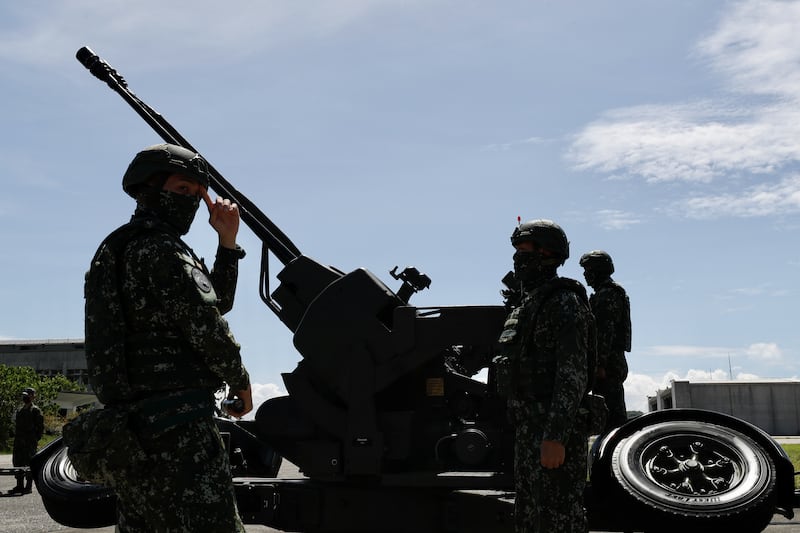Taiwan’s president Tsai Ing-wen had a tough message for Beijing this week. “We need to make the enemy understand that they will pay a very heavy price if they invade or try to invade Taiwan,” she said, as she commemorated the second Taiwan Strait crisis 64 years ago, when China launched an artillery barrage but failed to take Taipei-controlled outlying islands.
Deterring China is also front of mind for the US, the main guarantor of Taiwan’s security. Government officials and analysts in multiple countries said it was nearly impossible for the Biden administration to deny Beijing the ground it has gained in its pressure campaign against Taiwan without escalating the dispute, raising big questions about what the US will do next.
The People’s Liberation Army conducted seven days of unprecedented exercises around Taiwan this month in response to the controversial visit to Taipei of US House of Representatives speaker Nancy Pelosi. The PLA has continued to conduct daily air and naval movements closer to Taiwan than it previously did, with Taipei and Washington saying that Beijing has used the Pelosi visit as a pretext to change the status quo around the country.

“The status quo has been reset in ways less favourable to the US and Taiwan, and there are no good options for the US to respond to this,” said Ashley Townshend, senior fellow for Indo-Pacific security at the Carnegie Endowment for International Peace think-tank. “Like all status quo players, if you play responsibly and your adversary is willing to escalate, you lose the round.”
Unlike the 1958 attack, the PLA has kept its movements below the threshold of war. It fired missiles that traversed the sky over Taiwan but did not strike its territory. Its aircraft now cross the Taiwan Strait median line, a buffer previously respected by both sides, every day, but they turn back when Taiwan scrambles fighter jets.
In a reflection of the growing threat, Taiwan wants to steeply increase its military budget. The government is seeking to raise overall defence spending almost 14 per cent to NT$586 billion (€19.4billion) next year, according to a draft budget sent to parliament on Thursday.
[ The cost imposition on Taiwan over the Nancy Pelosi visit has only begunOpens in new window ]
Analysts said the PLA’s moves helped China to underpin its claim of sovereignty over Taiwan. “Their presence in the waters and airspace around Taiwan demonstrates that they can control it if they wish to,” said Kristen Gunness, an expert on the PLA at the Rand Corporation think-tank. She also saw this as a signal from Beijing that it could impose a quarantine regime under which China would control all air and sea trade in and out of Taiwan if it wanted to.
For the US, using military manoeuvres to roll back Chinese gains is out of the question because it could be seen as disproportionate and might trigger another escalation, analysts said.
“It is a dangerous time in terms of potential for escalation when you have a normalised PLA presence that could potentially restrict freedom of operations and freedom of movement, which is a key US objective,” Gunness said. “It was a large demonstration, and there hasn’t been the kind of diplomatic and economic follow-up that you might have expected. I think that is because we don’t want to escalate it into a larger conflict.”

Washington is signalling that, while it will not act rashly, it will not back down. The US response was “responsible, steady and resolute”, Kurt Campbell, the top Asia official in the White House, said last week. “We will not be deterred,” he said, adding that the US military would conduct another of its regular transits through the Taiwan Strait soon. Washington also wants to speed up sales to Taiwan of munitions and weapons vital for fighting an invasion.
On Thursday, the US Seventh Fleet said a carrier strike group had conducted several days of joint exercises with Japan’s self-defence forces in the Philippine Sea, part of the western Pacific south-east of Taiwan.
Some observers argued that might not be enough. “When the US says it will sail, fly and operate wherever international law allows, that is not deterrence, it’s just maintaining things – sort of cutting the grass,” Townshend said. “They are making a legalistic point, and a legitimate one. But it hasn’t deterred the PLA until now.”
Townshend added that the relative decline of US military power in Asia and the Pacific made things worse. “There is a tension between [President Joe Biden’s] rhetoric of having a commitment to defend Taiwan and the reality of US forces being increasingly poorly prepared to do that at an acceptable cost and risk,” he said. “In the past, it was a question of will, not capacity, what the US would do to protect Taiwan. Now it’s both.”
[ Decades of clashes with China led to Nancy Pelosi’s Taiwan tripOpens in new window ]
Against that background, the US Navy’s next Taiwan Strait transit will take on unusual significance. Some experts said options for stepping up deterrence against China included sailing more ships through the waters than usual, doing so with allies or even sending an aircraft carrier.
A senior Japanese official said the US and Japan should demonstrate their determination to prevent Chinese aggression. “We should not allow China to create a new normal,” the official said, adding that US-Japan joint exercises needed to “deter the creation of a new normal in this area”.
But Tokyo is an outlier. Japan would be directly affected by conflict over Taiwan because it hosts bases that US forces would use to intervene in war and its westernmost islands could become a staging ground for US Marines to enter Taiwan during a Chinese attack.
“Our other allies dislike the idea of a more robust response now,” said a US diplomat in the region.
As a result, Taiwanese hopes for a more muscular US response may be in vain.
“Until there is an egregious act of aggression of China against Taiwan, an unquestionable act of war, you are not going to get regional support for putting the burden of escalation back on China,” said Townshend. – Copyright The Financial Times Limited 2022










